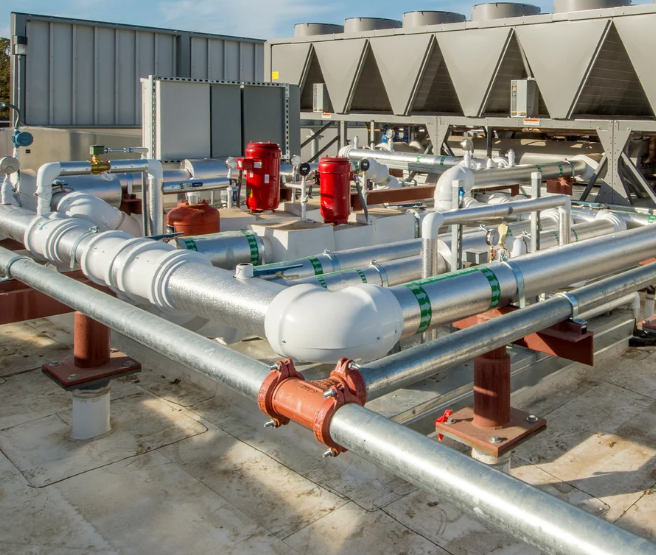When you think HVAC at scale, you’re talking about finding the right fit. Does your location need mega plumbing, air, and tech wizardry distributed across dozens of massive buildings or localized customization in a home? Let us dig in and cool down by exploring your needs and how these systems operate.
1. Central Plants & Chillers
For large-scale operations like lecture halls, dorms, research labs you need centralized cooling via chillers. Chill water and pump it through air handling units (AHUs) or fan coil units (FCUs) to regulate temps across campus zones with Water-cooled chillers, the gold standard for big buildings. These can slash energy use by 30–50% thanks to variable-speed drives and smart controls.
2. Zoning with VRFs, VAVs & Fan Coils
Large operations with different sized rooms have wildly different needs. Enter Variable Refrigerant Flow (VRF) systems, which let you heat or cool each spot independently, saving energy and keeping temp variation to a minimum. Meanwhile, Variable Air Volume (VAV) boxes route air volume precisely where it’s needed, paired with reheat coils for perimeter zones that bake under the sun. For simpler solutions, Fan Coil Units (FCUs) offer flexible, cost-effective local temperature tweaks—ideal for dorms or small offices.
3. Ventilation & Energy Recovery
Fresh, clean air is non-negotiable. Upgrade with Demand-Controlled Ventilation (DCV). These CO₂-sensor-driven systems that boost airflow only when occupancy spikes. Combine that with Energy Recovery Ventilation (ERV) or Heat Recovery Ventilation (HRV), and you recapture up to 80–95% of the energy from outgoing air to prep incoming air—like recycling comfort.
4. Smart Controls & Building Automation
Campus-wide HVAC needs oversight—and that’s where BAS (Building Automation Systems) step in. These systems tie HVAC, lighting, and sometimes even security into one brain, offering centralized monitoring and real-time tweaks. Meanwhile, advanced predictive controls like Model Predictive Control (MPC) help campuses forecast energy loads, dodge peak charges, and trim operational costs by around 7–8%.
5. Maintenance & Pandemic-Inspired Upgrades
Even the best systems need TLC. GW’s “ReStart” initiative audited over 120 campus buildings, upgraded filters, flushed air, tightened controls while driving energy efficiency. They sorted buildings into high-, medium-, and low-suitability categories to prioritize upgrades. Because lager scale HVAC isn’t just about comfort; it’s about sustainability and resilience.
6. Seasonal Ballet: From Heat to Cool Without Cracks
Switching systems from heating to cooling (and vice versa) is no trivial prank. It can take 24–36 hours for two-pipe systems on campus to safely shift modes because rushing it risks broken equipment. Let us help you plan.
Bottom Line: HVAC That’s Smart, Sustainable, and Stealthy
HVAC isn’t just giant air. It’s intelligent orchestration of chillers, zone controls, energy recovery, predictive automation, and maintenance, all synced to support learning, research, and comfort. From massive chillers to sneaky VRFs and air-recycling magic, these systems quietly ensure that labs function, students stay comfy, and energy costs stay in check, often without anyone noticing. Exactly how they like it.
